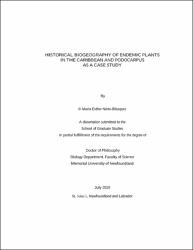/admin/item?itemID=b2501068-9b5d-432c-9813-ad7089dc9f54
Historical biogeography of endemic plants in the Caribbean and Podocarpus as a case study
Type of Access
OpenMaterial Type
TextType of Content
ThesisSubject
Biodiversidad - República DominicanaFlora ─ República Dominicana
Biogeografía
Historia natural
Hábitats y especies
Language
EnglishCollection
- Investigación ambiental [1725]
Metadata
Show full item record| Abstract: | Despite numerous floristic studies of the Caribbean region, the large-scale evolutionary origins of its diversity remain relatively under-explored. Here, I add to the empirical knowledge of the origin and assembly of the Caribbean flora by large-scale molecular analysis of the biogeography and phylogenetics of its constituent genera, with special emphasis on the conifer genus Podocarpus L’Hér. ex Pers. and its endemic species in the Antillean island chains. Connection of the Greater Antilles to northern South America by a late Eocene / early Oligocene land bridge, GAARlandia, has been hypothesized to facilitate colonization of the Caribbean islands. Well-calibrated estimates from molecular data of the ages of extant Caribbean endemic plant genera show a combination of relatively recent (late Oligocene / early Miocene) and older (late Paleocene / early Eocene) lineages, such that the GAARlandia hypothesis is not necessary to explain floral colonization of the Caribbean. Ancestors of most endemic genera included in my study were of Antillean origin. I show that diversity in Caribbean Podocarpus is paraphyletic, the result of a single colonization of the Greater Antilles from South America in the late Oligocene, species diversification leading to endemism beginning in the early Miocene, and dispersal to the Lesser Antilles from a Greater Antillean ancestor later in the early Miocene. Detailed examination of the phylogeography of the two endemic species on Hispaniola, P. buchii and P. hispaniolensis, shows an initial colonization to the southern palaeo-island of Hispaniola by a P. buchii ancestor. Subsequent northward stepping-stone migration is evident in the localization of genetic clusters across the main cordillera systems. P. hispaniolensis arose by progenitor-derivative speciation in the Central Cordillera. The assembly of Caribbean flora has been complex, and geology, vicariance, dispersal, and in situ speciation, together shaped the biotic assembly of the islands. "Abunda la tierra del Cibao (de Ciba, piedra de pinos mui altos que no llevan piñas, por tal orden compuestos por naturaleza, que parecen azeytunos del Axarafe de Sevilla" C. Columbus. |
| Author(s): | Nieto-Blázquez, María Esther
|
| Date: | 2019 |
| Published: | St. John's, Canada: Memorial University of Newfoundland |
| Citation: | Nieto-Blázquez, M. E. (2019). Historical biogeography of endemic plants in the Caribbean and Podocarpus as a case study (Doctoral dissertation). St. John's, Canada: Memorial University of Newfoundland. Recuperado de: |
| URI: | https://bvearmb.do/handle/123456789/3530
|


